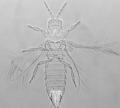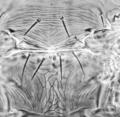Scirtothrips citri
Recognition data
Distinguishing features
Both sexes fully winged. Body mainly yellow without dark markings; antennal segments III–VIII grey; major setae pale; fore wings pale. Head wider than long; ocellar triangle and postocular region with closely spaced sculpture lines; three pairs of ocellar setae present, pair III close together between anterior margins of hind ocelli. Antennae 8-segmented; III–IV with forked sensorium. Pronotum with closely spaced sculpture lines; posterior margin with 4 pairs of setae, S2 prominent and about 40 microns long. Metanotal posterior half with irregular longitudinal reticulations; median setae close to anterior margin; no campaniform sensilla. Fore wing first vein with 3 setae on distal half, second vein with 3 widely spaced setae; posteromarginal cilia wavy. Abdominal tergites III–VI median setae small, close together; II–VIII with lateral thirds covered in closely spaced rows of fine microtrichia, these microtrichial fields with 4 discal setae, posterior margin with fine comb; tergite VIII comb complete, lateral discal microtrichia extend medially; tergite IX with several rows of discal microtrichia. Sternites without discal setae; lateral microtrichial rows scarcely extending mesad of setae S1; posterior margins without comb of microtrichia.
Male smaller than female; tergite IX without paired drepanae; hind femora without comb-like row of stout setae; sternites without pore plates.
Related and similar species
The Californian citrus thrips differs from the South African citrus thrips in not having the abdominal sternites covered with microtrichia; moreover, it lacks any dark markings on the abdomen. However, several other species have been described in California that cannot at present be distinguished satisfactorily from S. citri. The genus Scirtothrips currently includes 100 listed species from various parts of the world. Bailey (1964) provided keys to 13 from North America, but that work was based on specimens that were not fully cleared, and thus few structural details were available concerning differences between species. Similarly, Johansen & Mojica-Guzman (1999) provided keys to 33 species from Mexico, but doubts have been expressed concerning the biological reality of many of these (Mound & zur Strassen, 2001). Hoddle & Mound (2003) provided information on 21 Scirtothrips species from Australia, and Rugman-Jones et al. (2006) produced a molecular key to several pest species in this genus. Relationships of various Scirtothrips species based on molecular data are further considered by Hoddle, Heraty et al. (2008).
Taxonomic data
Current valid name
Scirtothrips citri (Moulton)
Original name and synonyms
- Euthrips citri Moulton, 1909: 119
- Scirtothrips clivicola Hood, 1957: 49
Family placement
Thripidae, Thripinae
Common names
Californian citrus thrips
Biological data
Life history
Breeding on young tissues of leaves and fruits; pupating on trees or in soil (Grout et al., 1986).
Host plants
The native host plant in California is a species of Rhus (Anacardiaceae), but the species occurs primarily on Citrus.
Tospoviruses vectored
None
Crop damage
Feeding results in distortion of young leaves, and surface scarring on citrus fruits.
Distribution data
Area of origin
Western USA
Distribution
California, Arizona, Mexico; specimens from populations in the southern States of the USA across to Florida are very similar in structure, but the genus requires further study.










